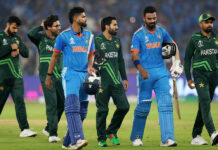In Pakistan, we often hear about the abundance of top-notch talent of cricket talent in our domestic circuit. Fans and media alike buzz with excitement, claiming our backups are ready to shine at the international level.
But when these players finally get their chance, many fail to make the impact expected of them. Why? The answer lies not in the talent pool but in how we nurture, manage, and introduce this talent to international cricket.
Read More: Is Sahibzada Farhan Ready for International Cricket?
The Problem Isn’t Talent, It’s Preparation
Pakistan’s recent performances tell the story. A 3-0 whitewash in a T20I series against Australia, followed by an 80-run loss (via DLS) to Zimbabwe in the first ODI on their tour, paints a grim picture.
Chasing a modest target of 206, Pakistan cricket team crumbled to 60-6 before the rain intervened. On paper, we’ve got players who have dominated the domestic scene. But on the field, many of them seem out of their depth.

Take Kamran Ghulam (29) and Sahibzada Farhan (28), two domestic stalwarts. While Kamran scored a century on his Test debut against England last month, he’s struggled to maintain consistency. Farhan, despite years of experience, looked completely lost at the international level.
Even our younger talents, like Haseebullah Khan and Irfan Khan, who are just 21, show promise but still appear raw. Haseebullah has all the makings of a future star, and Irfan could become a dependable middle-order hitter. But for now, they seem unpolished—players thrown into the deep end before learning to swim.
The Indian Contrast
Contrast this with India, where young players are not only stepping up but excelling on the international stage. In the first Test of the Border-Gavaskar Trophy against Australia, India fielded four players under 25: Yashasvi Jaiswal (22), Devdutt Padikkal (24), Dhruv Jurel (23), and debutant Harshit Rana (22).
Yashasvi Jaiswal’s stunning 161 in the second innings led India to victory, showcasing not just his talent but also his composure. The others contributed in smaller but significant ways, proving they belong at this level. What’s striking is their confidence—these players don’t look like rookies.

The difference? India’s system. Their players are prepared for the rigors of international cricket through a robust domestic structure, top-notch academies, and a clear development pathway.
Learning on the Job vs. Being Ready
In Pakistan, it’s a different story. Players often earn international caps based on a few standout performances in the Pakistan Super League (PSL) or domestic matches. Media hype and fan pressure play a huge role, and the Pakistan Cricket Board (PCB) frequently caves in.
But instead of debuting when they’re truly ready, our players are thrown into the deep end, expected to learn and develop on the job. The result? Inconsistent performances, shattered confidence, and a revolving door of players in and out of the team.
India, on the other hand, ensures their players are polished before they step onto the big stage. Domestic cricket isn’t just a stepping stone; it’s a testing ground where players prove they can handle all formats. By the time they debut, they’re already mentally and technically prepared.
Read More: ‘They Look Like Mummies’: Salman Butt Criticises Pakistan Players’ Fitness
A Change in Mindset Is Needed
The issue isn’t the lack of talent in Pakistan—it’s how we handle it. The PCB needs to focus on building a stronger domestic structure and creating a clear pathway for players to transition from domestic to international cricket.

Fans and the media also need to understand that international caps aren’t prizes to be handed out based on hype. It takes time, patience, and hard work to turn raw talent into consistent performers.
Until we shift our mindset and focus on proper development, the cycle will continue: hyped debuts, underwhelming performances, and the never-ending search for the next big thing.
Stay tuned to Brandsynario for the latest news and updates.





































